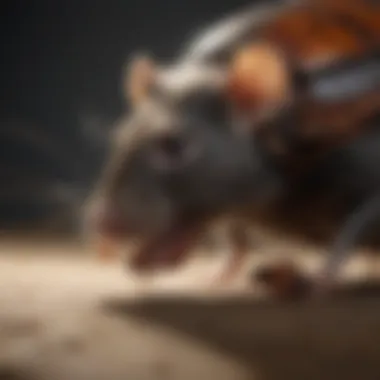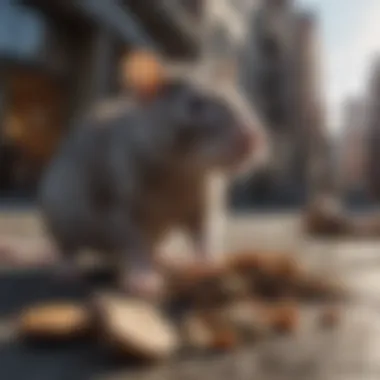Do Rats Eat Roaches? Understanding Pest Dynamics


Intro
Rats and cockroaches are both notorious pests found in urban environments. Their presence can lead to significant concerns for homeowners. Understanding whether rats eat roaches or if they compete for resources is vital for effective pest management. This article delves into the complex relationship between these two pests, shedding light on their diets, behaviors, and the impact they have on each other in shared habitats.
Understanding Pests
Definition of Pests
Pests are organisms that interfere with human activities, causing harm to health, property, or crops. Rodents like rats, and insects such as cockroaches fall into this category. Both can reproduce rapidly and thrive in human environments, making them challenging to control.
Importance of Pest Identification
Identifying pests is the first step in managing infestations. Knowing if you are dealing with rats, cockroaches, or both is crucial. Misidentification can lead to ineffective control measures. Proper identification helps in choosing the right approaches for prevention and eradication.
"Effective pest management requires knowledge and understanding of the specific species involved."
Dietary Preferences of Rats
Rats are omnivorous creatures with a varied diet. Their preference ranges from grains and fruits to meat and garbage. However, they are opportunistic feeders, which means they will consume whatever food source is available. In urban settings, they can resort to eating cockroaches if food resources are scarce.
Competition for Resources
Rats and cockroaches often inhabit the same environments, leading to competition for resources. While rats may eat cockroaches, this behavior is not their primary means of sustenance but rather a fallback when other food sources are not available. Understanding this dynamic can assist in determining pest management strategies that target both pests effectively.
Prevention Techniques
Home and Garden Preventative Measures
Preventing infestations from rats and cockroaches involves a multi-faceted approach:
- Seal Entry Points: Inspect your home for any gaps, holes, or cracks that may allow entry.
- Proper Waste Disposal: Keep garbage in sealed bins to deter both rats and cockroaches.
- Maintain Cleanliness: Regularly clean areas where food is prepared and consumed.
Seasonal Prevention Tips
Preventative strategies can vary by season. During warmer months, increased outdoor activities can lead to pests seeking shelter indoors. A few tips include:
- Fall Inspection: Check for and seal any entry points before winter.
- Spring Cleaning: Remove clutter in garages or basements to limit hiding spots.
Eco-Friendly Pest Control Solutions
Overview of Sustainable Practices
Sustainable pest control focuses on minimizing harm to the environment while effectively managing pests. Techniques include using traps rather than poisons and maintaining natural predators.
Natural Remedies and Their Effectiveness
There are several natural remedies that may deter both rats and cockroaches:
- Peppermint Oil: Its strong scent can repel various pests when applied around entry points.
- Borax and Sugar: A mix that can be effective against cockroaches, but must be used carefully to protect pets.
Understanding Rat Diet
Understanding rat diet is vital in comprehending the interactions between rats and cockroaches. Rats are opportunistic feeders, and their eating habits can provide insight into their behavior and ecological role. This section will examine the general eating habits of rats, their nutritional needs, and the types of foods they prefer. With this information, homeowners can better understand how to manage potential infestations and the broader implications for pest control strategies.
General Eating Habits


Rats have a diverse diet that largely depends on their habitat and food availability. These rodents will eat almost anything they encounter. In urban areas, where human activities produce ample waste, rats often scavenge for leftover food. Their chewing ability allows them to consume hard substances as well. It is important to note that rats tend to be nocturnal, which means they are more active at night. This behavior can impact their feeding patterns, making them more likely to search for food when there are fewer disturbances.
Nutritional Requirements
Rats require a balanced diet that includes different nutrients. Proteins, carbohydrates, fats, vitamins, and minerals all play a crucial role in their development and health. For their growth and reproduction, protein intake is particularly important. A lack of protein can lead to health issues such as stunted growth and weakened immune systems.
Their dietary fiber is necessary for digestive health. Most importantly, rats need water to survive. Without sufficient water, they can dehydrate quickly, which can lead to severe health issues. Therefore, understanding these requirements can aid homeowners in creating living environments that do not attract rats by providing sources of nutrition and hydration.
Types of Foods Rats Prefer
Rats exhibit preferences based on their nutritional needs and availability. They are known to favor:
- Grains and seeds
- Fruits and vegetables
- Meat and fish
- Nuts and legumes
- Processed food items such as bread and cereals
While rats will eat cockroaches and other insects if necessary, they typically prefer more substantial food sources. Understanding these preferences allows for targeted pest management strategies to minimize the availability of food sources, thus reducing the likelihood of attracting rats.
Key Insight: By recognizing what rats eat and their nutritional needs, pest control strategies can be designed to limit access to food sources, making environments less inviting for them.
Ecological Role of Rats
Rats are often viewed as pests, yet their ecological role is more complex. Understanding this role gives insight into their behavior and how they interact with other species, such as cockroaches. This section outlines the significance of rats in ecosystems, particularly urban settings. It highlights their adaptability and influence on various environments, helping to appreciate both their benefits and downsides. By recognizing the ecological niches they occupy, pest control strategies can be more effectively tailored.
Rats as Generalist Feeders
Rats are classified as generalist feeders. This means they have a diverse diet, consuming a variety of food sources. Their ability to exploit multiple food types makes them highly successful in urban settings. They eat grains, fruits, vegetables, and yes, even insects, like cockroaches. This adaptability not only allows them to thrive in cities but also places them in direct competition with other scavengers.
By preying on cockroaches, rats assist in controlling these pest populations. Although it is not their primary food source, evidence suggests that when other food options are scarce, rats will consume cockroaches. This behavior can make them a natural ally in the fight against cockroach infestations, as they can help keep their numbers in check. However, this predation also indicates potential competition for resources, particularly in densely populated urban areas where both species are frequently present.
Impact on Urban Ecosystems
The presence of rats has significant effects on urban ecosystems. They contribute to the food web by being both predators and prey. Their opportunistic feeding habits can influence the population dynamics of other species. For instance, when rats consume cockroaches, they can help reduce the competition for food resources available to other scavenging animals.
However, rats can also lead to negative impacts. Their feeding habits may pose threats to certain native species or contribute to the spread of disease. They can alter food availability for other organisms, creating an imbalance in the ecosystem. Pest control strategies must take into account the dual role of rats as both beneficial and detrimental. The challenge lies in balancing their ecological contributions while managing their population in urban environments.
"In urban ecosystems, rats play a dual role as both regulators and competitors, impacting the population dynamics of species like cockroaches."
In summary, rats significantly impact urban ecosystems through their generalist feeding behaviors. Their interactions with pests like cockroaches illustrate a complex dynamic that warrants further exploration, especially in pest management discussions.
Cockroaches: A Quick Overview
Cockroaches are often seen as unwelcome visitors in our homes. However, understanding these creatures is essential for grasping their impact on urban environments. This section provides an overview of cockroaches, focusing specifically on their species and behavior.
Common Species of Cockroaches
Several species of cockroaches inhabit urban areas, and knowing them can help identify potential infestations. The most common include:
- American Cockroach: Recognizable by its large size and reddish-brown color. It prefers warm, humid environments like basements.
- German Cockroach: Smaller and light brown, often found in kitchens and bathrooms. This species reproduces quickly, leading to significant problems for homeowners.
- Oriental Cockroach: Dark black and larger, it favors moist areas such as drains.
- Brown-banded Cockroach: Characterized by light brown bands across its wings. It tends to inhabit higher locations in buildings, such as ceilings.
Understanding these species is crucial for pest control strategies. Each species may require different approaches to effectively manage their presence.
Behavioral Characteristics
Cockroach behavior is a significant aspect of their resilience as pests. They are primarily nocturnal, preferring to scavenge for food at night to avoid predators. In addition to this, they exhibit certain traits:
- Social Behavior: Cockroaches can communicate and may exhibit social interactions, such as grouping together in environments that provide food.
- Diet Flexibility: These pests are omnivorous scavengers. They can consume a variety of organic matter, including food scraps, paper, and even glues.
- Survival Tactics: Cockroaches have a high reproduction rate and can live without food for long periods, making them persistent nuisances.


"Cockroaches are incredibly adaptable creatures that can thrive in various environments, causing significant challenges in urban pest management."
In summary, recognizing different cockroach species and their behaviors will enrich understanding of their interactions with other pests, like rats. This knowledge fosters more effective control measures, benefiting homeowners seeking to maintain a comfortable living space.
Interactions Between Rats and Cockroaches
Understanding the interactions between rats and cockroaches is central to this exploration. It is crucial to recognize how these two pests coexist in urban environments, as their relationship can influence pest control strategies and homeowner experiences. By examining the nuances of their interactions, we gain insights into the behaviors and ecological roles that each species plays, thus enriching our comprehension of pest management efforts.
Predation vs. Competition
The relationship between rats and cockroaches can be characterized by both predation and competition for resources. Rats are omnivorous foragers, known to consume various food sources, including insects like cockroaches. Historically, evidence suggests that rats do prey upon these pests, particularly when food is scarce. Cockroaches, on the other hand, can also be competitors. They inhabit similar environments and seek out the same food sources, particularly in urban settings where food waste is abundant.
- Predation:
- Competition:
- Studies indicate that rats can hunt cockroaches, especially larger species.
- This predatory behavior contributes to the population control of cockroaches in some areas.
- Both species often forage in the same locations, leading to competition for food sources.
- This competition can impact the population dynamics of both rats and cockroaches.
Understanding whether rats are primarily predators or competitors helps homeowners strategize their pest control efforts. Knowing that rats may help in keeping cockroach populations in check could lead to more effective approaches against these pests.
Survival Strategies
Both rats and cockroaches have developed unique survival strategies that allow them to thrive in their habitats. These strategies significantly affect how they interact with one another. Cockroaches tend to be nocturnal and can quickly hide from predators, including rats. Their adaptability is one reason they survive even in environments with rat populations.
Rats, meanwhile, possess remarkable intelligence and social behavior. They are known to create burrows and establish territories that may influence cockroach presence in the area. This territorial behavior can lead to conflicts over food sources or space. Over time, both species have adapted their behaviors to avoid confrontations while securing resources necessary for survival.
- Cockroaches' Adaptations:
- Rats' Strategies:
- Quick reflexes and excellent hiding abilities.
- Ability to reproduce rapidly to maintain population numbers.
- Social cooperation, using group dynamics to forage effectively.
- Creating nests in inaccessible areas to minimize competition.
Understanding these survival strategies gives valuable insight into controlling both pest populations effectively. Homeowners can use this knowledge to anticipate and mitigate potential infestations.
Do Rats Eat Cockroaches?
Understanding whether rats consume cockroaches is pivotal in grasping the interaction dynamics between these two species within urban settings. Rats, as notorious scavengers, can have dramatic impacts on the ecosystem, particularly in areas where human habitation provides ample food sources. The dietary habits of rats not only reflect their adaptability; it is also vital for homeowners to be aware of these aspects to effectively manage pest populations. Examining this connection can shed light on the broader ecological implications and help in pest control strategies.
Evidence of Rats Consuming Cockroaches
Research indicates that rats do include cockroaches in their diet when other food sources are limited. Observations have shown rats foraging through kitchens and waste areas, where cockroaches are often present. The presence of rat droppings near cockroach activity suggests that they can and do feed on these pests. In controlled studies, instances have been recorded of rats consuming various species of cockroaches like the German cockroach and the American cockroach, indicating a level of dietary preference.
- Dietary Preference: Rats have been observed selecting cockroaches not only from their natural habitats but also where they coexist with human food waste.
- Survival Behavior: During periods of drought or food scarcity, rats are more likely to resort to cockroaches as a protein source.
"Rats display remarkable adaptability in their feeding behaviors, oftentimes resorting to other pests when traditional food sources dwindle, underscoring their role as opportunistic feeders."
Factors Influencing Rats' Dietary Choices
Various factors govern the dietary decisions of rats, impacting their consumption of cockroaches. Some key aspects include:
- Availability of Food Sources: When traditional food sources are scarce, rats are more inclined to consume cockroaches.
- Nutritional Needs: Rats require a balanced diet that includes carbohydrates, proteins, and fats. Cockroaches can fulfill some of their protein needs.
- Environmental Conditions: Conditions such as urban density, sanitation levels, and availability of shelter can influence the interactions between rats and cockroaches. A high-density area with poor sanitation often leads to more encounters between the two.
- Competing Species: The presence of other species, such as mice or other rodents, can also influence a rat's dietary habits, pushing them towards cockroaches if these competitors target the same food sources.
Ultimately, observing these interactions can provide insight into the larger pest control dynamics in urban areas. Identifying the conditions that facilitate these dietary choices may aid homeowners and pest control professionals in developing effective strategies to manage both rats and cockroaches.
Implications for Pest Control


Understanding the relationship between rats and cockroaches is crucial for effective pest management strategies. The overlap in their habitats often leads homeowners to wonder whether rats eat cockroaches, and if this has any impact on pest control measures. Identifying how these two pests interact provides insights into their behavior and helps in developing a more comprehensive approach to pest management.
Rats can either serve as a natural control for cockroach populations or exacerbate pest problems. This dual role means that pest control professionals need to evaluate both species when designing effective strategies. By understanding rats' eating habits and dietary preferences, one can tailor interventions to minimize both rodent and cockroach infestations. The goal is to create a more effective pest management program, improving both safety and sanitation at home.
Rats in Pest Management Strategies
Rats are often seen as pests themselves, but their predation on cockroaches may play a significant role in managing these common nuisances. Incorporating knowledge of rat behavior into pest control strategies can enhance the outcomes of pest management programs. For instance, if rats are indeed consuming cockroaches, this might reduce the overall cockroach population. However, relying solely on rats to control cockroaches is not a viable solution. The presence of rats can create a false sense of security, leading to inadequate action against cockroaches and neglecting food safety.
Integrating rats into pest management strategies involves:
- Monitoring Rat Behavior: Regular checks can help assess if rats are preying on cockroaches in the environment.
- Focusing on Bait Stations: If rats are consuming cockroaches, bait stations that attract rats can also indirectly address cockroach infestations.
- Assessing Environmental Conditions: Cleaning up food sources and potential nesting sites can deter both species, making the environment less hospitable.
Combining Control Measures
Adopting a multi-faceted approach is essential when dealing with both rats and cockroaches. Combating these pests requires a blend of traditional control measures with modern insights into pest interactions. Here are some effective methods:
- Exclusion Techniques: Ensure that cracks and entry points in walls and foundations are sealed to prevent both rats and cockroaches from entering.
- Sanitation Practices: Maintaining cleanliness is crucial. Reducing food sources and waste can discourage both pests from making a home inside.
- Chemical and Natural Solutions: The use of traps, bait, or insecticides should be conducted in a manner that takes into account the potential effects on rats as well. Certain baits may harm non-target species, including the rats that may predation on cockroaches.
"Integrated pest management strategies are more effective and sustainable, addressing the ecological roles of pests while promoting healthier environments."
Combining these methods allows for a tailored strategy that maximizes efficiency. Further research can enhance understanding, enabling homeowners and pest control experts to develop customized plans that minimize the need for potentially harmful chemicals. Ultimately, this creates a safer, healthier home environment.
Health Risks Associated with Rats and Cockroaches
The presence of rats and cockroaches in any environment raises significant concerns regarding health risks. Both of these species are known carriers of various diseases, which can pose serious risks to humans and pets. Understanding these risks is crucial for homeowners and pest control professionals alike. Such knowledge aids in taking proactive measures to mitigate potential health dangers associated with these pests.
Effective pest management goes beyond mere elimination; it involves understanding the intricate interplay between these species and their potential impact on human health. From recognizing which diseases are prevalent in urban settings to understanding how these pests can contaminate living spaces, the importance of addressing this topic cannot be overstated.
Diseases Carried by Rats
Rats are notorious for harboring several pathogens that can adversely affect human health. Key diseases include:
- Leptospirosis: This bacterial infection results from exposure to water contaminated with rat urine. Symptoms can range from mild flu-like signs to severe liver damage and kidney failure.
- Salmonellosis: Often transmitted through contaminated food, rats can shed Salmonella bacteria, leading to gastrointestinal issues. This disease is especially concerning in homes where food hygiene may be compromised.
- Hantavirus: This virus is transmitted through contact with rat droppings. It can cause Hantavirus Pulmonary Syndrome, a severe respiratory disease.
- Rat-bite fever: Though rare, this illness can occur through bites or scratches from rats. It can lead to fevers, rash, and joint pain.
Addressing the presence of rats in an area is essential for reducing these health risks. Cleaning up food sources and maintaining sanitation can significantly lower the likelihood of disease transmission.
Diseases Spread by Cockroaches
Cockroaches are not just an irritating pest; they pose health risks through their ability to contaminate food and living spaces. Some diseases associated with cockroaches are:
- Asthma and Allergies: Cockroach droppings, saliva, and shed skin can trigger allergic reactions and asthma attacks, especially in sensitive individuals.
- Salmonella: Similar to rats, cockroaches can carry Salmonella and contaminate food and surfaces, leading to gastrointestinal infections.
- E.coli: Cockroaches can pick up this bacterium from decaying food and waste. Its presence can cause significant illness if ingested.
Maintaining a clean home environment is crucial to reduce the population of cockroaches. Regular cleaning, sealing food containers, and eliminating areas of moisture can help stop infestations.
By understanding the health risks associated with rats and cockroaches, homeowners can better protect themselves and their families from potential diseases.
End
In this article, we have explored the complex relationship between rats and cockroaches, shedding light on their interactions and dietary behaviors. Understanding whether rats consume cockroaches is not just an academic inquiry. It is directly relevant to pest control strategies and home management.
Summary of Findings
The investigation revealed that rats are opportunistic feeders. They will eat cockroaches when other food sources are scarce. This behavior significantly affects the population dynamics of cockroaches in urban settings. Rats can subsist on various food, indicating a wide diet. However, the mere presence of cockroaches does not guarantee they will be preyed upon by rats. Environmental factors, availability of other food sources, and presence of competing species all play critical roles in these dietary choices.
"Rats are generalist feeders, which means their diet heavily relies on accessibility and scarcity of food types."
Future Research Directions
Looking forward, further research is needed to understand the detailed interactions between these two species. Future studies could focus on:
- Behavioral Patterns: More insights into how environmental changes affect rat diets.
- Health Implications: Understanding diseases transmitted through cockroaches when consumed by rats.
- Pest Control Efficacy: Evaluating the effectiveness of pest management strategies that account for their interactions.
Diving deeper into these areas will ultimately help homeowners and pest control professionals develop more effective strategies to manage these creatures in residential spaces.



